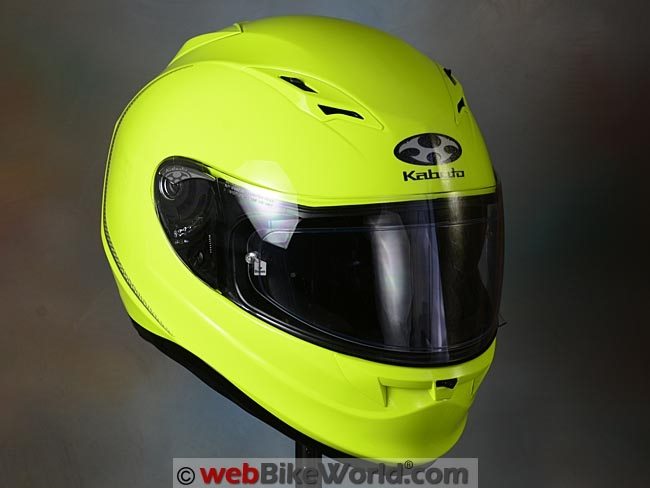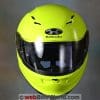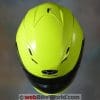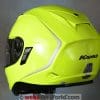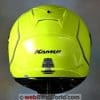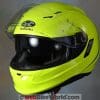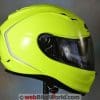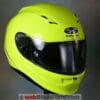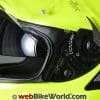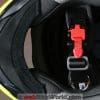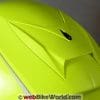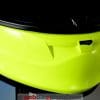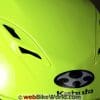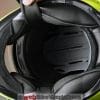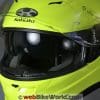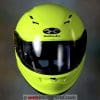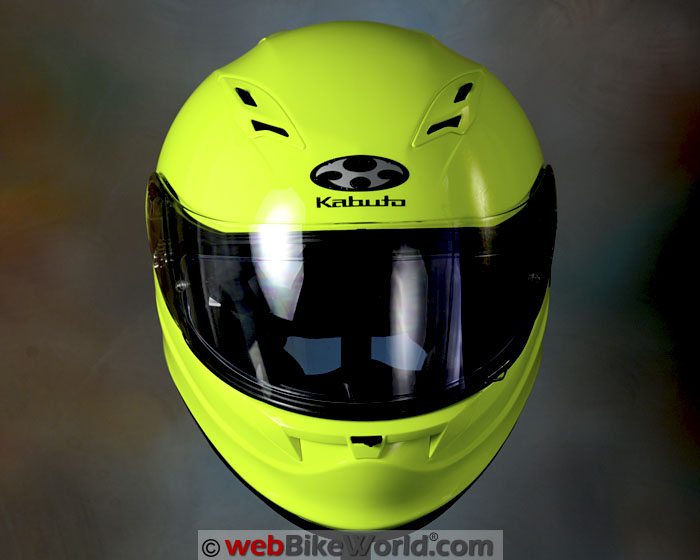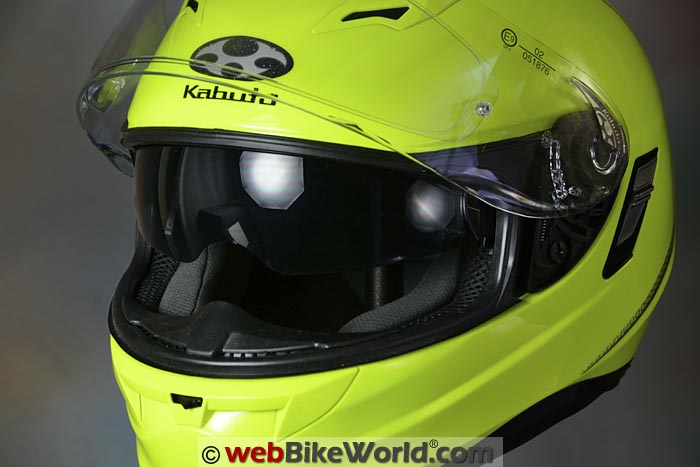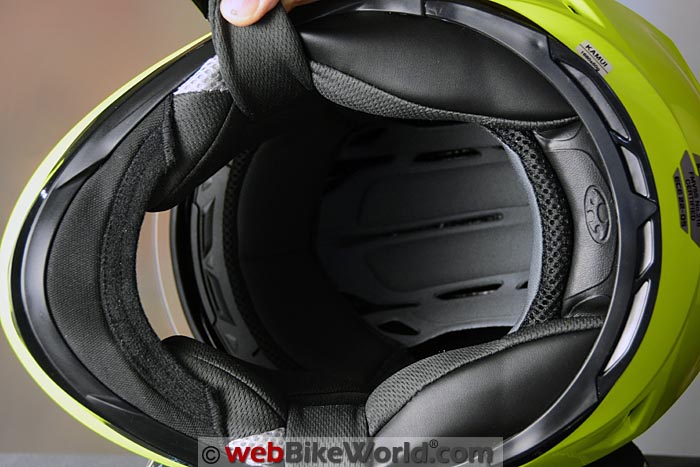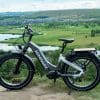A helmet that fits? A miracle!
The Kabuto Kamui is said to be the helmet for sport touring, aka street riding.
And it’s perfectly suited for that task…especially for us “Round” heads.
The level of quality belie the Kamui’s low list price; it’s just a penny under 250 bucks.
It hits the bull’s eye between expensive Arai and Shoei helmets, while feeling more substantial than lower-priced brands like HJC.
If you’re still pining for a “Round Oval” replacement for your Arai Quantum II, this is it.
Kabuto is the (relatively) new name for OGK, one of my favorite helmet brands that sort of flies under the radar for most motorcyclists.
The Japanese company has been making a small but growing line of helmets for nearly 40 years and I’ve always been impressed by the design and quality of the products.
The Kamui follows closely to this OGK/Kabuto design ethic. The word “Kamui”, by the way, is apparently Japanese for “a spiritual or divine being in Ainu mythology”. There are some Kamui (or Kamuy) gaming characters also, with special powers.
This Kamui is the least expensive full-face helmet in the Kabuto lineup, a fact which surprised all of us here in webBikeWorld land. I assumed it would have around a $350.00 to $400.00 list, so you’re getting a lot for two-hundred-and-fifty bucks.
And it’s one of the very few helmets I can slip over my “Round” or “Earth” shaped head and feel instantly comfortable — a feeling that I rarely get.
I discussed the fit and internal shape with a Western Power Sports rep (the U.S. distributor), who said the Kamui was designed to fit something like an Arai RX-Q (review). That seems pretty close, although my feeling is the Kamui feels just a touch rounder inside, compared to my own RX-Q that I frequently wear.
In fact, the Kamui feels identical to the original (and revolutionary) OGK FF-3 I reviewed, way back in 2003, when the brand was relatively unknown outside of Japan.
Background
Since both the Kabuto brand name is somewhat new to the U.S. market, I’ll repeat here what we wrote in the review of the Kabuto Aeroblade III. Just for reference, we also have a , the Kabuto FF-5V (review) and the OGK FF-4 review for your viewing pleasure.
Kabuto used to be known as OGK, a Japanese company making helmets for nearly 40 years now. The OGK FF-3 (review) was reviewed on webBikeWorld in 2003 and at the time, the helmet came from the UK. It was revolutionary for its time, in that it was very light and it had excellent aerodynamics and super ventilation. In fact, it was my “go-to” hot-weather full-face helmet for many years.
OGK and now Kabuto helmets are known for outstanding ventilation and aerodynamics with thoughtful design and high quality, but at a lower price point than Arai or Shoei.
This philosophy continues with the Kamui, which is the least expensive full-face helmet in the current lineup but which has the same Kabuto genes, with an excellent design, good looks, excellent build quality and comfort that somehow combine to make it uniquely Kabuto.
By the way, it’s getting harder — not easier — to review motorcycle helmets. The quality and features have improved dramatically in the 15+ years that webBikeWorld has been online and it’s actually difficult to find a “bad” helmet any more. Sure, you might not like one or the other and one may work for you while another doesn’t, but overall, the state of the art is much different than it was in the past.
Paint, Graphics and Overall Quality
The Kamui comes in solid colors, including the “Flash Yellow” high-visibility version shown here, a color that flummoxed the Nikon’s sensor. Red/black and yellow/black versions area also available, as it a nice “Fluente” graphic in matte white or matte black for $50.00 (list) extra.
The Kamui is listed as Kabuto’s “sport touring” helmet and it’s perfectly suited to that role. All of the Kabuto (or OGK) helmets I’ve worn have a certain feel or ambience that marks the marque and even though the Kamui is the least expensive full-face in the lineup, it still has that feel.
I’d classify it as having a better design and build quality than an HJC and nicely splitting the difference between HJC and more expensive brands. It’s a case of paying a little more and getting a lot more I think.
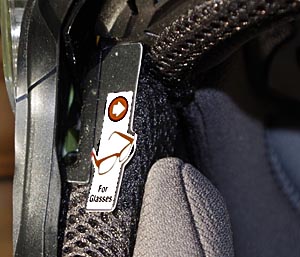
While it’s always difficult to evaluate paint and graphics on a solid-color helmet, this Kamui has outstanding build quality, with tight split lines around the vents and a beautifully finished exterior, with a high gloss surface and not a hint of overspray, orange peel, dust or anything else under the surface.
In fact, I’d say the finish is the equivalent of just about any helmet I’ve handled at just about any price.
The moving parts all have a solid feel and the liner definitely looks and feels more upscale than the list price might indicate. The only slight nit I can pick is the vinyl around the bottom of the helmet, which fits perfectly with no quality flaws but is a bit less posh than you might find on, say, an Arai or Shoei.
But if that’s the only issue, I’ll buy 2 Kamuis and use the leftover change for 5 tanks of fuel, thank you.
The Kamui also comes with a Pinlock anti-fog insert; it was installed on this helmet, which was kind of a surprise, and there’s another in an unopened package in the box. Not sure how that happened, because it’s only supposed to have one included.
The liner is very comfortable and the Kamui also has a cutout along the top of the cheek pads for eyeglass wearers.
One note on the shell shape: the styling around the bottom of the Kamui can make it slightly difficult to fit some intercoms, so you may have to use the stick-on mount instead.
Score: The Kabuto Kamui gets an “Outstanding” rating from us for finish and overall quality. See the Summary Table at the bottom of the page for a description of our rating system.
Fit, Sizing and Internal Shape
Western Power Sports (the U.S. distributor for Kabuto) once told us that the helmets designed for the Japanese and Asian markets use a “Round” internal shape or head form, while helmets for the Australian, North American and European markets have an “intermediate” shape.
That proved true on previous Kabuto helmets but the Kamui has what we call a “Neutral” to “Round” internal shape. My guess is that to keep costs low — and thus keep the list price of the Kamui reasonable — a different head shape was not designed and we’re getting the single Japanese/Asian rounder internal shape.
This is good news for us round-heads, who have been forgotten by most helmet manufacturers! As soon as I slipped the Kamui on, I could feel the difference, and it’s a good one.
I also have an Arai RX-Q handy, along with two new limited-edition Arai Corsair V helmets I’ll be reviewing soon (in the fantastic Nicky 5 and Isle of Man TT graphics), all of which have the Arai “Intermediate Oval” internal profile, it’s easy to compare.
The Kamui feels very similar to the Arai helmets, but the Arai Intermediate Oval shape forms more of a slight oval at the forehead. But that extra space doesn’t do much for round heads.
As always, there are no absolutes with helmet fit and shapes but the bottom line here is that I’ll call the Kamui a “Neutral” to “Slightly Round” in the webBikeWorld parlance (see the Motorcycle Helmet Shapes page).
I have received many emails in the past 6 months or so from ex-Quantum and RX-Q owners looking to replace their lid and I’ll say this: you’ll want to check out a Kamui. It’s about as close to the old Quantum II as you’ll find but at 1/3 the price.
The Coolmax liner fabric and the generous padding are very comfortable, adding to the overall impressions of the Kamui.
One more thing: the Kamui has deep ear pockets that are unlined, making it fairly easy to stick one of the hook-and-loop pads to hold the speakers. Don’t forget, speakers work best when they’re close to your ears, so you may want to add some spacers under the speakers and most intercom systems have those as part of the kit.

More information on helmet fit can be found in the webBikeWorld Motorcycle Helmet FAQ page, along with the chart that lists the helmet weights of webBikeWorld reviewed helmets and also by shape on the webBikeWorld Motorcycle Helmet Shapes page.
Score: The Kabuto Kamui gets an “Outstanding” rating for fit, comfort, liner materials and padding.
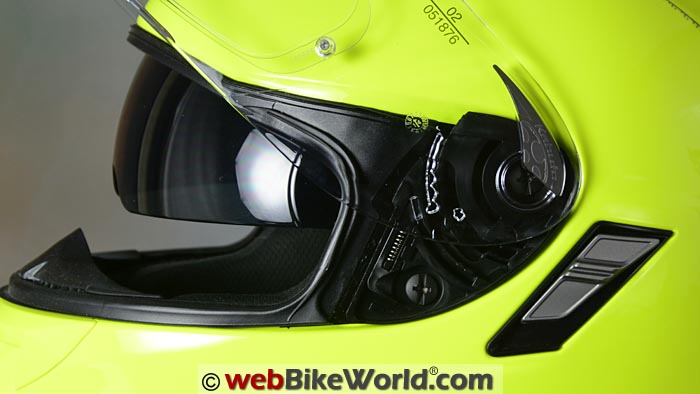
Face Shield, Eye Port and Visibility
Kabuto (and OGK) are/were focused on sport and racing helmets, but the Kamui is defined as a “sport touring” (read: street) helmet. Thus, it gets the internal sun visor treatment.
I’m not really a fan of an internal sun visor, because they mostly add weight, almost never have the darker tint I’d like and they usually don’t provide enough coverage. The most important issue, however, is that the internal sun visor takes up precious crush space at the forehead, an important safety factor. This is why Arai went to the external sun visor type with the Arai Pro Shade (review). It’s also why — as far as I know — there are no Snell certified helmets with an internal sun visor.
The sun visor in the Kamui works well enough though, with a nicely integrated (and easy to find) slider on the left-hand side. It’s more or less an on/off type, although with care, the sun visor can be stopped in an intermediate position.
Like most helmet internal sun visors, this one doesn’t quite have all the travel I’d like, but overall, it’s a good one and internal sun visor fans should be pleased.
The outward visibility is good; I’ll call it average for a full-face helmet, so nothing unusual here.
The face shield has the “perfect” first opening city position for defogging of 10 mm, then opens through 6 total detents as it’s raised. They eye port gasket appears to be very thin but it works and here’s where Kabuto quality comes into play, as the face shield on this helmet has a perfect fit with tight clearance against the helmet shell. It passes the leak-down test with ease and the water is directed along the top of the gasket and then out both sides towards the bottom.
The Kamui comes with a Pinlock anti-fog insert, which was installed on this helmet for some reason with an extra Pinlock in the box. I’m not a fan of the Pinlock insert either, because the edges appear in my peripheral vision, but I was reminded once again at how well it works to prevent fogging in the cold-ish and wet-ish Spring riding weather we’ve had recently.
The face shield has the EC markings (the helmet meets DOT and ECE standards) although the face shield is thin. We measured this one at 1.425 mm, down about 0.60 mm from average (the Kabuto Aeroblade III face shield measured 2.08 mm thick). The optical quality of the face shield is very good.
Also, the face shield has a little “Kabuto” logo on either side, kind of a nice touch that adds some class to the helmet compared to those plain old generic face shields.
The Kamui removal system is very easy to use. Pull down on a release and two plastic tabs hold the face shield in place. To replace it, simply snap it back in.

Score: The Kabuto Kamui gets an “Excellent” rating for the overall quality and operation of the face shield.
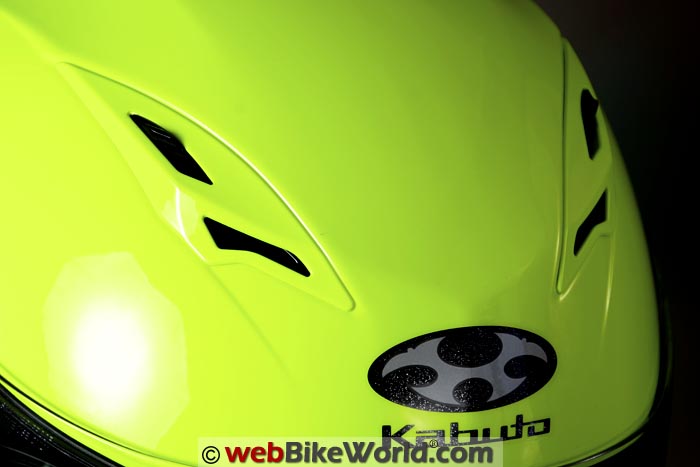
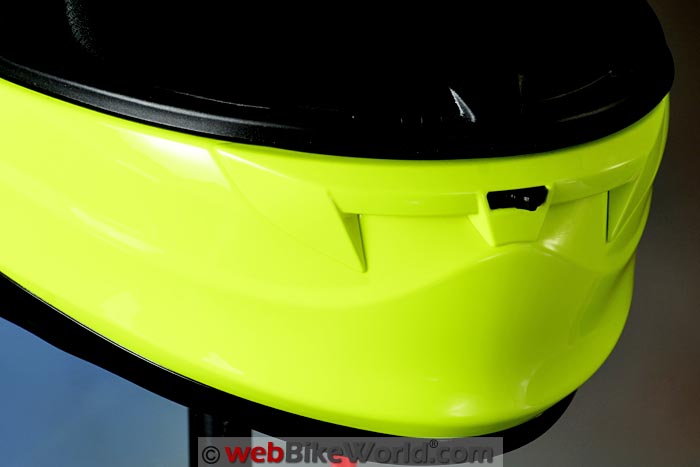
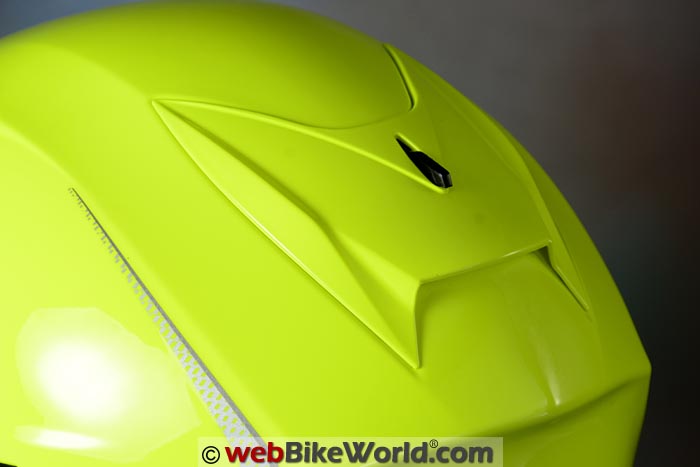
Ventilation
The ventilation in the Kamui is good; I’d rate it as slightly better than average. There are no direct ports through the chin bar, so the air that comes in flows up through the top of the chin bar along the bottom of the eye port and this provides a good quantity of air for ventilation.
The top vents sit in low-profile housings and are independently operated. The upper ventilation system is sort of unusual; a pair of holes through the EPS are located towards the front and the air also flows over the top of the EPS and then down into another pair of holes at the rear of the rider’s head.
While I can’t say that I can feel a tremendous amount of air flowing through, the system works well enough and helps to keep the noise under control, more or less.
There’s also an on/off rear exhaust vent under a low-profile housing. It’s difficult to see underneath, but the two vents are open when the slider is pushed towards the rear.
The Kamui also comes with an attached chin curtain, which is a bonus.
Overall, the Kamui ventilation system functions a little better than the average full-face helmet and there shouldn’t be many complaints, I would imagine.

Score: The Kabuto Kamui ventilation system rates a “Very Good” overall.
Kabuto Kamui Noise Control
Noise control is difficult to assess and rate, but overall, the Kamui does a pretty good job. The low-profile vents and tight tolerances around the edges probably help here, as does the near-perfect (for me) fit and the ample padding.
Noise is well controlled, although when sitting upright, some additional noise at the top vents can be heard. As always, your mileage will vary and if your bike has a windscreen that dumps air around the top of the helmet, the noise may increase.
The helmet shape does seem to “cut through the air” with good aerodynamics, which helps. The Kabuto shape with the “wake stabilizer” must be working.
Overall, I’ll rate the Kamui as slightly better than average for noise control.

Note that our helmet evaluations are a combined effort of several riders over time on different types of motorcycles with and without windscreens.
Evaluators wear correctly fitted, high quality ear plugs (even when evaluating motorcycle intercom systems).
Always protect your hearing when riding a motorcycle. See the wBW Earplug Reviews for more information on choosing and wearing earplugs.
Note also that perceived noise levels will vary, depending on the individual.
Noise can be caused by many factors, including helmet fit, the type of motorcycle and windscreen, wind speed and direction and even the rider’s clothing.
For more information on helmet noise, visit the wBW Motorcycle Helmet Noise page.
Score: The Kabuto Kaumui rates an “Excellent” rating for noise control.
Helmet Weight
This Kabuto Kamui in size L (58-59 cm) is a bit heavy at 1707 grams (3 lbs., 12-1/4 oz.). The internal sun visor probably accounts for some of the extra weight. But the nice fit and good aerodynamics help, so the helmet weight doesn’t feel or seem abnormal for a full-face sport/touring helmet.
Note also that all of the helmets reviewed on webBikeWorld have been weighed and the weights are available on the wBW Motorcycle Helmet Weights page, along with a chart that lists the helmets by weight and shape on the wBW Motorcycle Helmet Shapes page.
Score: The Kamui gets a “Very Good” rating for its weight and good balance.
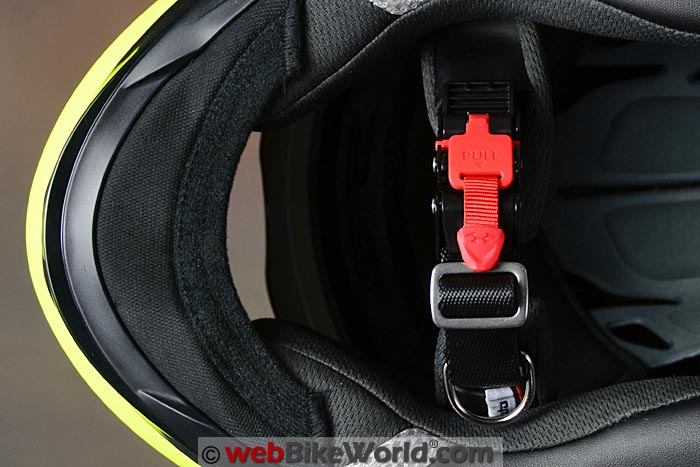


Miscellaneous
The Kamui has a quick release chin strap retainer, which I suppose is acceptable for this type of helmet, although I much prefer the lighter, simpler and proven double D-ring type. The chin strap has a metal D-ring for locking via a cable to the bike. The chin strap padding is adequate.
wBW Opinionator: Kabuto Kamui Helmet
- Excellent quality.
- Comfortable fit.
- Nice styling.
- Competitive price.
- Water sealing.
- “Quick Release” buckle.
- Pinlock installed?
Conclusion
The Kamui is another Kabuto winner, with a high-quality build that belies the price and lots of nice features, right down to the metal D-ring locking loop on the chin strap. If you’re a “Neutral” to “Round” headed rider, definitely check this one out.
This is a lot of helmet for the money and it’s too bad more motorcyclists aren’t aware of the brand. But, lower marketing costs mean better bargains and it’s kind of cool to be “in the know” right from the beginning of the OGK and Kabuto brand.
Overall, I’d have to say the Kamui is currently the best deal going for $250.00 and it would probably still be a favorite at $350.00 to $400.00. Just don’t tell Kabuto… Round heads, rejoice! Your helmet is here.
Owner Comments and Feedback
See details on submitting comments.
From “S.O.” (September 2015): “I purchased this helmet based on your review and it really is a good helmet for us “Earth” shaped heads… that is the part above the eyes.
I still feel like the cheek pads are way too tight and I feel like I’m trying to impersonate a chipmunk. You know, when it’s so tight that you can’t chew gum and ride or you’d have chewed through the sides of your cheeks.
I also want to comment about the rubber gasket and the possibility of someone not being able to use a comm device. I was able to install my Sena SMH10 pretty easily, so that shouldn’t be a concern.
Yes, it does stick out sideways a bit more, but it does fit and doesn’t interfere with the drop down shield lever.
I furthermore want to mention that it is definitely skewed towards touring. When I ride my Sprint ST, I have a normal view of everything and the Pinlock insert is not noticeable. When I ride my Hawk GT however, the top line of the Pinlock is directly in the middle of my view and is very distracting.
I would assume that anyone who rides a sport bike will have the same issues. I simply use a different helmet for that bike…
I still love my GMax 11D which I removed the visor. Great earth-shaped-head-friendly helmet.
Overall though, I am very happy with the purchase and would recommend this helmet to anyone looking for a great helmet, but is looking at not spending the amount for a similar Shoei or Arai. Appreciate your site!”
Rick’s Reply: Thinner cheek pads in size XS to XXL are available from Kabuto as an option. But don’t go too thin, you need the tight fit on the sides for best protection!
Also, the sun visor in the Kamui is the clue that this is a touring-oriented helmet. We just reviewed the Kabuto RT33, a street/track day helmet.


From “M.K.” (June 2015): “I purchased a Kabuto Kamui for the new riding season, after deciding to retire my trusty Shoei RF1000. The Kamui fits my head fine, when compared to the fit of my Shoei, and the size is medium for both.
After using the Kamui recently on a week-long 2,400 mile trip that included rain, and high (+80 MPH) speeds, I found the helmet’s performance to be great, especially with its price tag of $250.
Cons:
- Shield is thinner than the Shoei. Not a big deal, but it does scratch much easier than the Shoei’s.
- Although I really do like the chin strap’s quick-release, buckle feature, more than the traditional D-rings, it’s finicky when you want to unlatch it.
- Noise level is about on par with my old Shoei. Not too quiet, but not a deal-breaker.
- I am sold on the internal sun shield. Love it. But like others state, it could be longer. Too wide of a gap between bridge of nose and it.
Pretty much sums up things. The Kamui is a very good helmet for the price, and a keeper for me, for years to come.”
From “E.W.” (May 2015): “I enjoy reading your reviews and find them very informative, but I have one comment/criticism. On at least 3 helmet reviews (Kabuto Kamui, HJC CL-17 and FG-17) you have the country of origin listed as China.
While many of the HJC helmets are made in China, the 2 listed are made in Vietnam. The Kabuto is made in Japan. I had written off the HJC helmets because I assumed they were all made in China ( I won�t support their economy if I have any choice) and it was only at the insistence of the parts guy at my local shop that I tried it on and noticed the country of origin.”
Editor’s Reply: We list the country of manufacture that is printed in the label of the products, if it’s there. Some manufacturers have factories in multiple countries and/or exports and imports are made based on currency fluctuations, delivery schedules and more factors.
So it’s quite possible that the same product will list a different country of manufacture, depending on the time and location, etc. But as I said, we only list the country that is shown in the label. If we can’t find it on the product or the box, it is listed as “Unknown” or “N/A”.
Most of the new Kabuto helmets, including the Kamui, are indeed made in China. In fact, I was surprised at this myself, because the other Kabuto/OGK helmets we reviewed were indeed made in Japan. So I contacted the U.S. Kabuto rep and he confirmed that the helmets are made in China.
I guess it’s possible there is still a Japanese factory and maybe they sell the made in Japan helmets in Japan or elsewhere. But the U.S. helmets are made in the Kabuto China factory, according to Kabuto USA.
From “M.F.” (May 2015): “I have one of these helmets and, overall, I am very happy with it. Well-made, fits me great (especially over my eyeglasses and big ears), quiet, comfortable, etc.
The one thing I really, really don’t like, though, is the quick-release chin strap. The closure is a plastic box with a relatively sharp edge that presses directly into my throat. Even padded and covered with Gorilla tape it still hurts.
I’ve gotten used to it, but it’s still uncomfortable. So I would call this helmet a 95 percent success for me.”
From “D.M.” (April 2015): “Regarding the Kabuto Kamui helmet, I am happy for you, and envious, that you found a helmet shaped like your now-famous “earth” head. Good-looking and inexpensive as well; wow! (The helmet, not your head.)
I recently tried on a Kamui at a dealership where they recommend the Kabuto brand for “eyeglass friendliness.” That’s a good feature in a helmet, but since I am more in the long-oval camp, Kabuto and I are not a harmonious pairing.
I am shopping for a replacement for my XL Shoei X-11 (review) and XXL Arai Profile (review), which to me fit exactly the same. Thanks to your great reviews, I had almost settled on an XL Shoei GT-Air (review), but came to realize that that model raises my glasses up off my nose. I can almost wear a size Large in the GT-Air, but the eyeglass fit is much worse in that size!
My second choice, an XL Arai Signet-Q (review), isn’t as comfortable as the GT-Air, but is completely eyeglass-friendly. I hate to spend the extra money for the Arai, but being able to use one’s eyeglasses is pretty darn important.
I have never owned a helmet with an internal drop-down sun visor, but in trying on lots of helmets recently, I have come around to your view that they aren’t dark enough and don’t come down far enough. If they add complication and weight, and compromise safety, score another point for Arai.
My point here is to encourage you to keep evaluating the little things that are so important. The contrast between wBW reviews and the usual, “It’s new! We like it! Buy it!” reviews published elsewhere is stark, and disheartening. So, Please keep beating your head against that brick wall; discerning enthusiasts are with you!”


